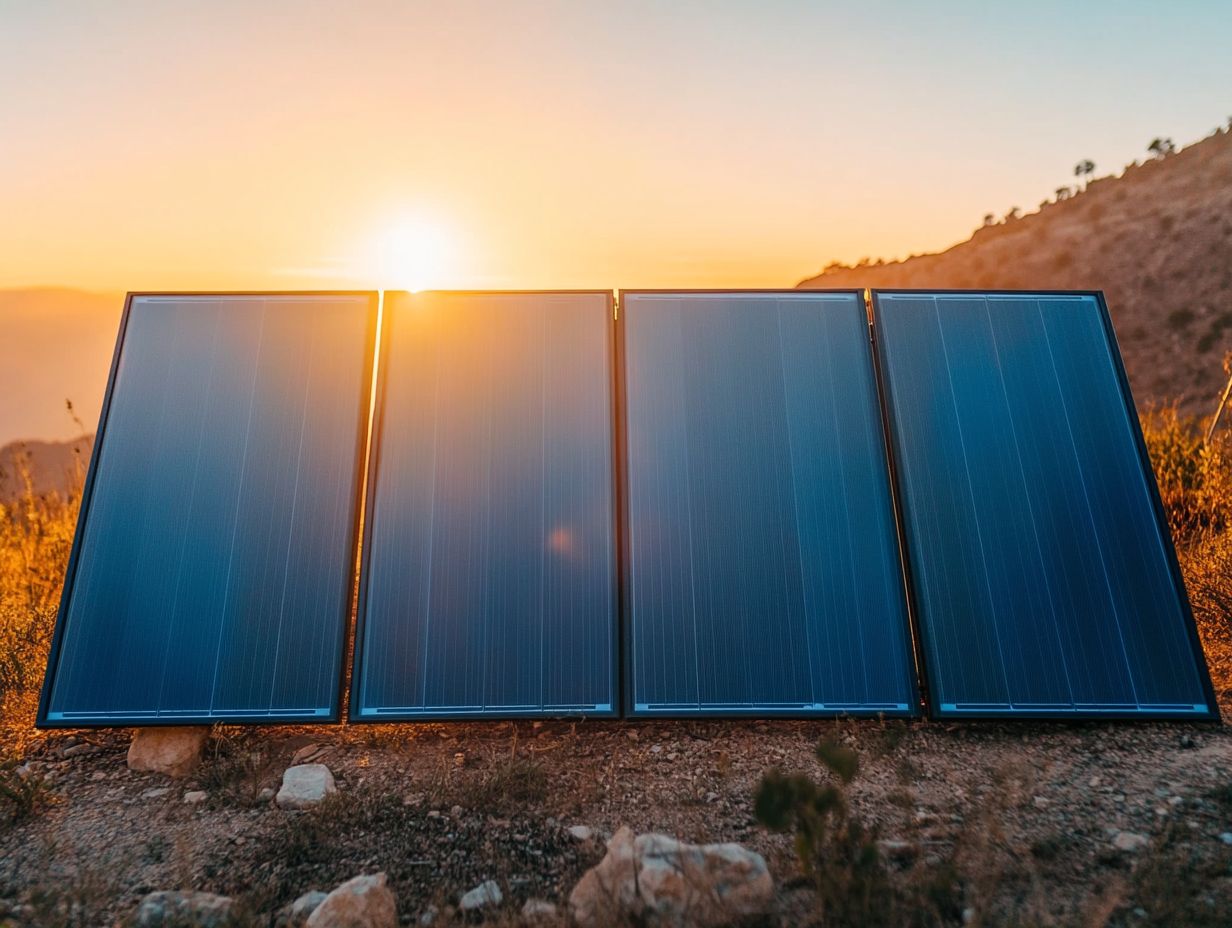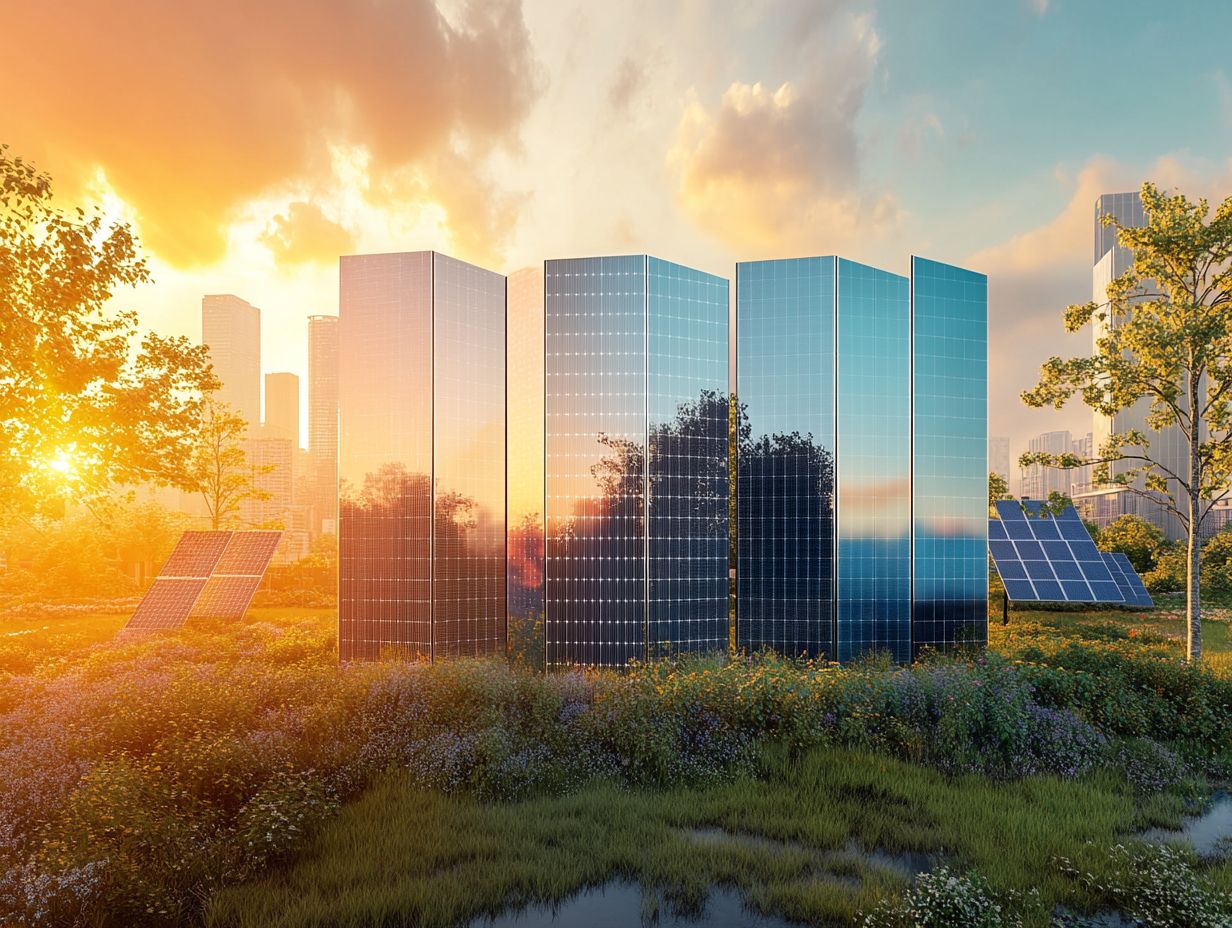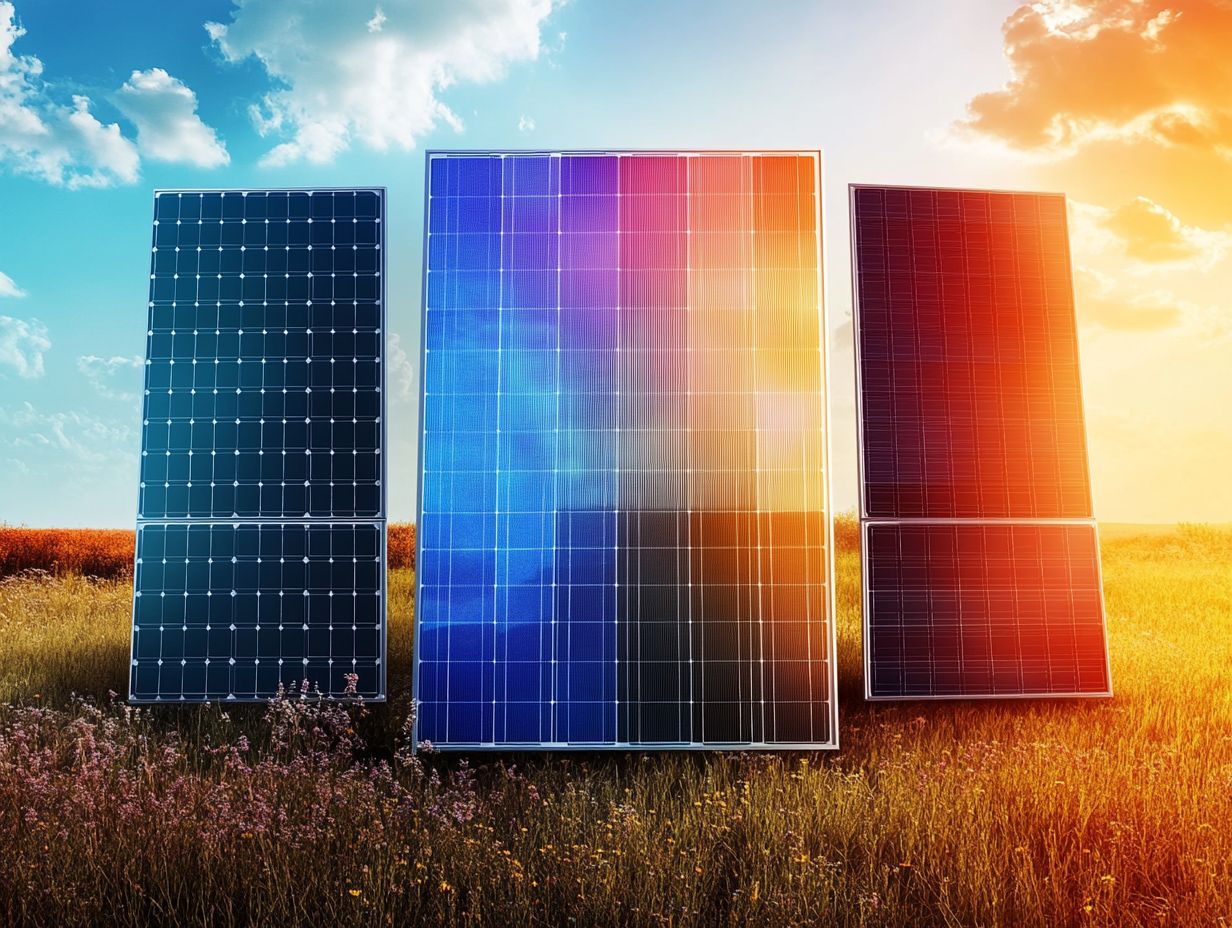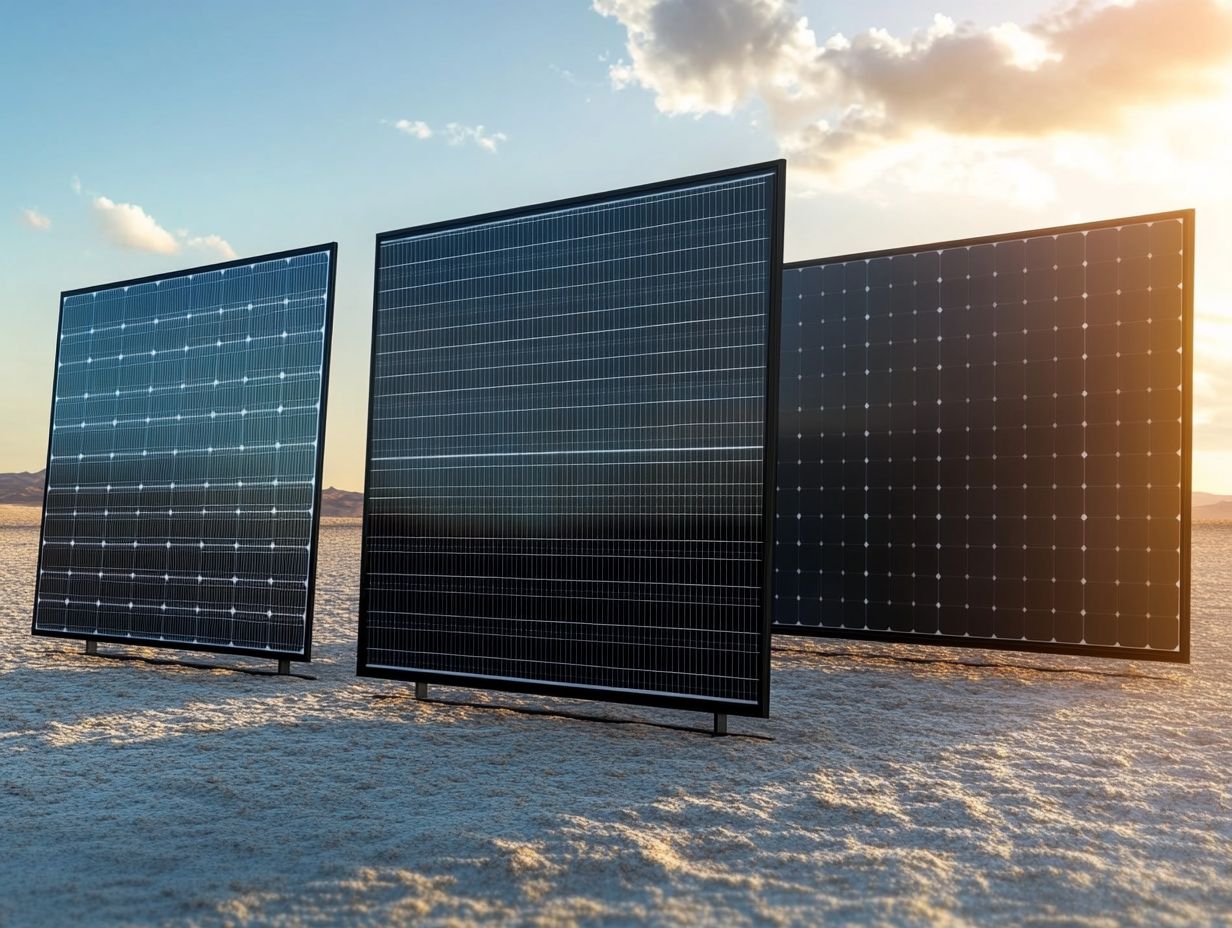What are the Different Types of Solar Panels?
Solar panels are revolutionizing how you harness energy, making sustainable living more attainable than ever.
With a range of options available, understanding the differences between monocrystalline, polycrystalline, thin-film, and Building-Integrated Photovoltaics (BIPV) solar panels is essential for making an informed decision.
Considerations such as efficiency, cost, durability, and installation requirements can significantly influence your choice.
This guide will help you determine which type of solar panel aligns best with your needs and budget.
Are you ready to explore your solar possibilities?
Contents
- Key Takeaways:
- Types of Solar Panels
- Factors to Consider When Choosing Solar Panels
- Which Type of Solar Panel is Right for You?
- Frequently Asked Questions
- What are the Different Types of Solar Panels?
- What are the advantages of using thin film solar panels?
- What is the difference between a photovoltaic (PV) solar panel and a thermal solar panel?
- Are there any new or emerging types of solar panels?
- Which type of solar panel is right for my home or business?
Key Takeaways:

- Solar panels are devices that convert sunlight into electricity through photovoltaic cells.
- The main types of solar panels are monocrystalline, polycrystalline, thin-film, and BIPV.
- When choosing a solar panel, consider factors like efficiency, cost, durability, and installation requirements based on your needs and budget.
What are Solar Panels?
Solar panels, also known as photovoltaic panels, are remarkable devices that convert sunlight into electricity. By harnessing solar energy, these panels help promote energy independence and reduce reliance on fossil fuels.
They are critical in the broader landscape of renewable energy sources and showcase advancements in solar technology that enhance energy efficiency and sustainability for both residential and commercial applications.
Now is the perfect time to understand how these devices work! Essentially, solar panels consist of numerous solar cells made from semiconductor materials like silicon, which generate direct current (DC) electricity when exposed to sunlight. An inverter then transforms this DC into alternating current (AC), making it suitable for everyday electrical applications.
You’ll find various solar panels available, including monocrystalline, polycrystalline, and thin-film options, each offering distinct advantages tailored to specific energy needs. The growing integration of solar technology not only addresses environmental concerns but also brings significant economic benefits, such as reduced electricity bills and potential tax incentives. This makes solar energy an appealing choice for countless households and businesses.
Types of Solar Panels
You ll find a variety of solar panels on the market, each with distinct characteristics and performance metrics tailored to diverse energy needs and applications.
The primary categories include monocrystalline, polycrystalline, and thin-film solar panels. Building-Integrated Photovoltaics (BIPV) provide innovative solutions that harmoniously integrate into architectural designs.
Understanding the nuances of these solar panel types is crucial for making informed decisions about your energy solutions and maximizing your energy savings.
Monocrystalline Solar Panels
Monocrystalline solar panels stand out for their exceptional efficiency and longevity, making them an ideal choice for residential or commercial solar systems. Crafted from high-purity silicon, these panels typically boast an impressive efficiency rating of 15-22% and can last over 25 years under optimal conditions.
Their superior temperature coefficient ensures performance remains stable, even in high temperatures, reinforcing their reputation for quality. This characteristic makes them particularly advantageous for locations with limited roof space, as they generate more power in a smaller area compared to their polycrystalline counterparts.
You ll commonly find them used in rooftop installations for homes and businesses, as well as in larger solar farms. While the initial installation cost can be higher often ranging from $10,000 to $15,000 for a typical home system the long-term savings on electricity bills and the potential increase in property value often make it worthwhile.
Plus, the sleek, uniform appearance of monocrystalline panels enhances the aesthetics of your installation, appealing to those who prioritize visual harmony in their homes.
Explore your solar options today and start saving on energy costs!
Polycrystalline Solar Panels
Polycrystalline solar panels present a cost-effective choice to their monocrystalline counterparts, making them appealing for budget-conscious consumers. Crafted from multiple silicon crystals, these panels come with a lower production cost. You may notice slightly lower efficiency ratings of around 13-16%. Still, their robust performance and respectable energy output keep them in high demand for many residential solar systems.
The production process kicks off with melting raw silicon in a furnace. This allows it to crystallize into blocks that are subsequently sliced into wafers. This approach is less costly than the single-crystal method employed for monocrystalline panels, which often necessitates higher purity silicon and more energy during manufacturing. While polycrystalline panels may not quite match the efficiency levels of their monocrystalline rivals, they excel in larger installations where space isn t a primary concern.
By choosing these panels, you position yourself for significant long-term energy savings. This makes them a practical choice for those looking to reduce upfront costs while still committing to renewable energy solutions.
Thin-Film Solar Panels

Thin-film solar panels stand out with their lightweight and flexible design. This allows you to explore a range of applications, from unconventional surfaces to portable solar solutions. Made from materials like cadmium telluride (a compound used in solar cells) and copper indium gallium selenide (a thin-film technology), these panels offer the advantage of lower installation costs and a streamlined production process.
While their efficiency typically hovers around 10-12%, keep this in mind for your solar needs, whether as a homeowner or a business owner.
However, don’t underestimate the unique benefits of thin-film technology. They excel in niche markets, thriving on curved rooftops or even in wearable devices. Compared to crystalline options, which generally boast higher efficiencies of 15-22%, thin-film alternatives are particularly well-suited for space-constrained applications.
Their ability to perform better in low-light conditions makes them a promising choice for areas that don t bask in direct sunlight. As the solar market evolves, thin-film panels are becoming increasingly relevant, driven by a growing demand for innovative, flexible, and efficient solutions tailored to diverse needs.
Building-Integrated Photovoltaics (BIPV) Solar Panels
Building-Integrated Photovoltaics (BIPV) – solar panels that are built into the structure of a building – represent a cutting-edge approach to solar technology. They allow you to seamlessly integrate solar panels into the very fabric of your building rather than adding them as an afterthought. This innovative design not only boosts the aesthetic appeal of your space but also enhances energy efficiency, positioning them as ideal for modern architecture and sustainable building practices.
As the need for renewable energy sources grows, BIPV panels play an essential role in achieving energy savings and reducing carbon footprints.
Their versatility is impressive, allowing for incorporation into roofs, fa ades, and even windows, effortlessly blending functionality with visual appeal. However, it s worth noting that potential drawbacks include higher upfront costs and some challenges in energy generation efficiency compared to traditional solar panels. While performance metrics can vary, ongoing advancements in technology are steadily improving their output.
Act now to prioritize your energy independence! BIPV solar panels emerge as a significant player in the dialogue surrounding sustainable architecture. By embracing unique designs that maintain aesthetic integrity, BIPV sets the stage for a greener future without compromising the essence of your building.
Factors to Consider When Choosing Solar Panels
When choosing solar panels, you must take into account several key factors, such as installation costs, efficiency ratings, durability, and potential energy savings.
Each of these elements significantly influences the overall effectiveness and financial viability of your solar investment. Whether you decide on monocrystalline, polycrystalline, or thin-film solar options, grasping these considerations will enable you to make well-informed choices that align with your unique energy requirements and budget.
Efficiency
Solar panel efficiency refers to the percentage of sunlight transformed into usable electricity. This crucial metric helps assess solar technology.
When you opt for higher efficiency, you benefit from greater energy output on a smaller surface area. This leads to significant energy savings and potentially lower installation costs, especially in tight spaces.
The temperature coefficient is another critical factor influencing efficiency. It measures how temperature changes affect solar panel performance.
For example, you ll find that monocrystalline panels usually boast higher efficiency ratings than their polycrystalline counterparts. This enables you to make informed decisions tailored to your unique needs and site conditions.
These efficiency ratings impact not only the initial costs of purchasing and installing solar systems but also your long-term savings on energy bills. Recent innovations, like bifacial solar panels and advancements in materials, have further elevated efficiency levels, making solar options more enticing and accessible for a wider audience.
Cost
Solar panel costs are important to consider for your savings! They encompass both the initial installation expenses and the long-term investment in energy savings.
While monocrystalline panels tend to be pricier due to their advanced technology and efficiency, polycrystalline and thin-film options provide budget-friendly alternatives. Evaluating the money you make back from your investment over time is essential for making informed financial decisions about your solar solutions.
Understanding the various installation methods can significantly impact your overall expenses. For instance, rooftop installations may vary in cost based on your roof’s slope and accessibility, while ground-mounted systems might require more extensive site preparations.
As you explore financial incentives, don t overlook the Solar Investment Tax Credit (ITC), which can substantially reduce your upfront costs. Many regions also offer local rebates, making the transition to solar even more enticing.
Act now to maximize your savings with available financial incentives! By taking advantage of these, you can effectively lower your initial investment while positioning yourself for long-term savings.
Durability

When selecting solar panels, durability is paramount. It directly influences their lifespan and performance over time.
Opting for high-quality panels means you re choosing ones designed to withstand a range of weather conditions think hail, fire, and extreme temperatures. This ensures reliable energy production for decades to come.
With regular maintenance and monitoring, you can further enhance their durability, safeguarding your solar investment and maximizing energy efficiency. To assess this resilience, look for certifications like IEC 61215 for design validation and IEC 61730 for safety testing.
These certifications involve rigorous testing protocols that simulate real-world conditions, including heavy snowfall and severe winds. They confirm that the panels can endure adverse weather.
Installation quality is crucial as well. Panels positioned at the right angle and in appropriate locations can significantly reduce the risk of damage from debris or shifting weather patterns.
Keep in mind that varying local climates and environmental factors can impact the longevity of these systems. It s essential to partner with reputable installers who truly understand the regional challenges at play.
Installation Requirements
Understanding the installation requirements for solar panels is crucial for ensuring a successful setup. Whether you’re looking at residential or commercial systems, considerations like roof structure, orientation, and local regulations all play a role in determining installation costs and the overall efficiency of your solar energy system.
Proper planning and hiring experienced installers are key to optimizing performance and meeting safety standards. Familiarizing yourself with the typical installation process, which includes site assessments and mounting options, is essential. Acquiring the necessary permits is vital, as different municipalities may impose varying regulations regarding solar energy systems.
If you re contemplating a solar investment, selecting qualified installers can significantly impact your experience. Make sure to check their certifications and customer reviews before making a decision. A professional evaluation of your site is also crucial, as it ensures that factors like shading and roof condition are adequately addressed. This ultimately leads to a more efficient and reliable solar setup.
Which Type of Solar Panel is Right for You?
Choosing the ideal solar panel for your unique circumstances requires a careful evaluation of your energy needs, budget, and specific applications. Consider factors such as available space, local solar incentives, and preferred brands like Q Cells or REC Group, as these can significantly impact your decision.
By understanding the benefits and drawbacks of each type of solar panel, you can pave the way toward energy independence while optimizing your solar investment.
Assessing Your Needs and Budget
Start your solar journey by figuring out your needs and budget! Assessing your needs and budget is key in selecting the right solar panel system for your home or business. Consider key factors like your average energy consumption, available roof space, and long-term energy savings that will guide you to the perfect fit.
A thorough analysis will clarify the investment required and ensure that your chosen solar solutions align seamlessly with your sustainability goals and financial efficiency.
It s also vital to evaluate potential cost savings over time. Keep a keen eye on your local energy costs and utility rates. By conducting a detailed cost-benefit analysis, you can weigh the upfront installation expenses against the long-term savings and advantages.
Don t wait! Taking advantage of available incentives like tax credits or rebates can significantly enhance the project’s financial viability. Explore various financing options like solar loans or leases to find payment structures that fit your budget.
Frequently Asked Questions
What are the Different Types of Solar Panels?

There are several types of solar panels, including monocrystalline, polycrystalline, thin film, and bifacial. Monocrystalline panels are made from a single crystal of silicon, while polycrystalline panels are made from multiple fragments of silicon fused together.
What are the advantages of using thin film solar panels?
Thin film panels are lightweight, flexible, and can be easily integrated into building materials, making them popular for residential and commercial installations.
What is the difference between a photovoltaic (PV) solar panel and a thermal solar panel?
Photovoltaic (PV) panels convert sunlight into electricity, while thermal solar panels use sunlight to heat water or air for direct use in homes or buildings.
Are there any new or emerging types of solar panels?
Yes, bifacial solar panels are becoming more popular. These panels can absorb sunlight from both sides, increasing their efficiency.
Which type of solar panel is right for my home or business?
The best solar panel for you depends on your needs and location.
Talk to a solar expert to find the best option for your situation.






